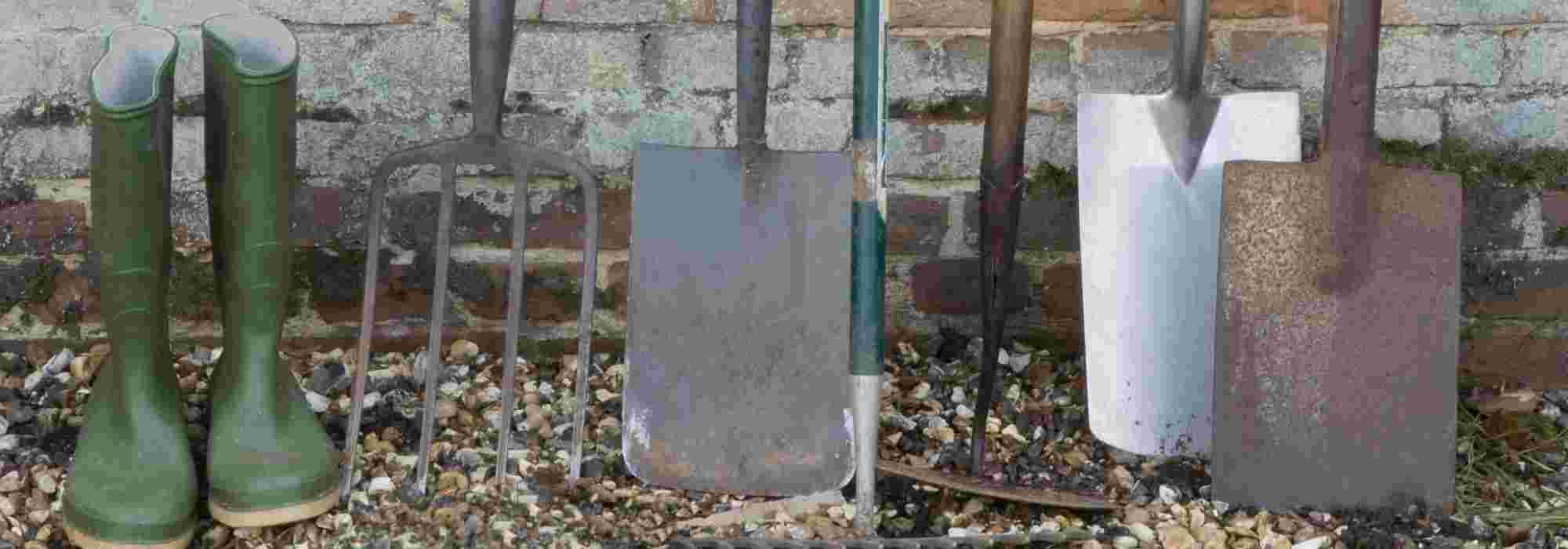
Main gardening tools and their functions
How to choose and use them effectively
Contents
In the garden, good work starts with choosing a good gardening tool — robust, practical and, above all, suitable. Unfortunately, when wandering through the “garden tools” ray florets of garden centres, you can sometimes feel a little lost. What is this strangely named tool? Will I need it? How should I use it? No need to panic! Here is a quick summary of the usefulness of the main gardening tools and some tips for choosing them.
Spade, spading fork, hoe and broadfork
Spade
A spade consists of a flat blade wide enough at the top to rest a foot on and help the blade enter the soil. This blade is mounted on a shaft, usually ash wood, and finished with a “T” handle for easier use (some older models still have a straight handle). Spades are used to dig planting holes, remake bed edges, cut roots, pull up vegetables or plants to move… but above all to prepare ground by mixing layers of soil: spading consists of loosening soil by turning it over; this action also allows manure to be worked into the soil.
When buying, make sure the shaft suits your build; it should just exceed hip height. A quality blade should be steel and feature a flat piece on top to rest the foot without damaging shoes. The shaft must be sturdy and “flexible“, that is able to withstand twisting and leverage. The best wood for this use remains ash but other modern composite materials now exist. Finally, weight is a factor to consider: do not buy a tool you can barely lift; conversely, a tool that is too light will struggle to penetrate heavy soil.
Spading fork
On this tool, the flat blade is replaced by three, four or, rarely, five straight steel tines. The spading fork also loosens soil but without turning soil layers and without severing earthworms, which are essential to soil life. The spading fork is also used to lift and move certain plants, as well as to divide large clumps of perennials. It is particularly useful in heavy, sticky soils, such as clay, but also in very stony ground. Generally choose a spading fork (in Switzerland it is also called “triandine”) with a shaft slightly longer than that of a conventional spade. Here too, select a tool with a steel blade and a shaft in ash wood or composite materials.
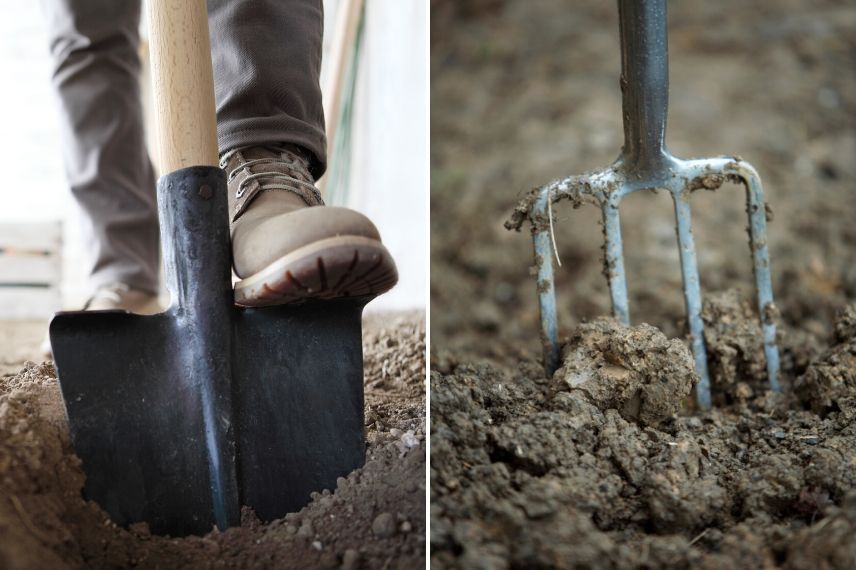
Spade and spading fork
Nursery spade
The nursery spade resembles a simple spade but its blade is longer, often thinner and sharper and noticeably narrower. Originally used to dig trenches or extract turf, this tool proves very effective in heavy soils because it penetrates more easily. The nursery spade is also a “nurseryman’s spade” because this tool makes it easier to move trees and bushes by penetrating deeper into the ground to pass beneath the roots. The nursery spade is made like a spade except that it has a “socket” that acts as a sheath for the shaft to stiffen it and protect it from soil. The nursery spade’s blade is also often polished to prevent heavy soils sticking to it.
→ Find Olivier’s advice sheet: “What is a nursery spade?”
Broadfork
The broadfork is more or less a very wide spading fork. This tool consists of a long blade featuring a row of curved, sharp tines, and two wooden handles on the sides to allow manipulation. Like its smaller relative the spading fork, the broadfork loosens and aerates soil without turning it over. Unfortunately, its use is limited to fairly light soils with few stones. This tool nevertheless has another advantage: it allows work without damaging the back. Indeed, simply drive the tines into the soil then pull the handles towards you, thus preserving the gardener’s back.
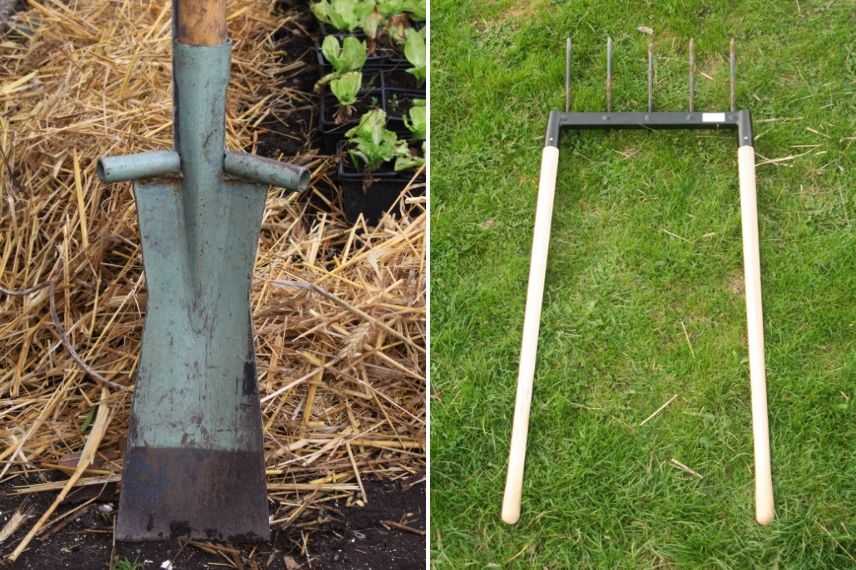
Nursery spade and broadfork
→ discover our range of spades, nursery spades and spading forks as well as Olivier’s video advice to help you choose your tools.
Garden fork
A fork is a tool made up of a handle and long, thin, pointed tines, set well apart: their number and length vary depending on use. It is used to lift and move bulk materials such as hay, dead leaves, branches, compost, manure… The best forks have a slightly curved handle and very sharp tines for better penetration into material.
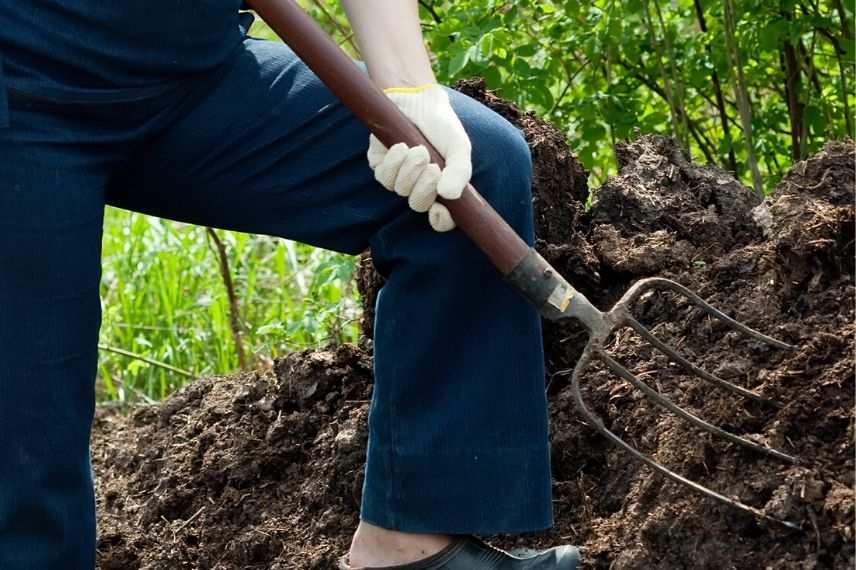
Fork
Discover other Digging and cultivation garden tools
View all →Available in 1 sizes
Available in 1 sizes
Available in 1 sizes
Available in 1 sizes
Available in 1 sizes
Available in 1 sizes
Available in 1 sizes
Available in 1 sizes
Shovel
Shovels allow moving material that cannot be transported with a fork: sand, dead leaves, gravel… but also compost, soil, manure… This tool consists of a flat head, varying in roundness and depth. There are several types of shovel: the “round-headed” shovel, which allows easier penetration into material to be shovelled, the “flat-headed” shovel, which is used to scrape flat surfaces, and the “scooped-headed” shovel, which carries more material without spilling it everywhere. Finally, note that long handles reduce back strain but shorter handles provide greater stability when moving loads.
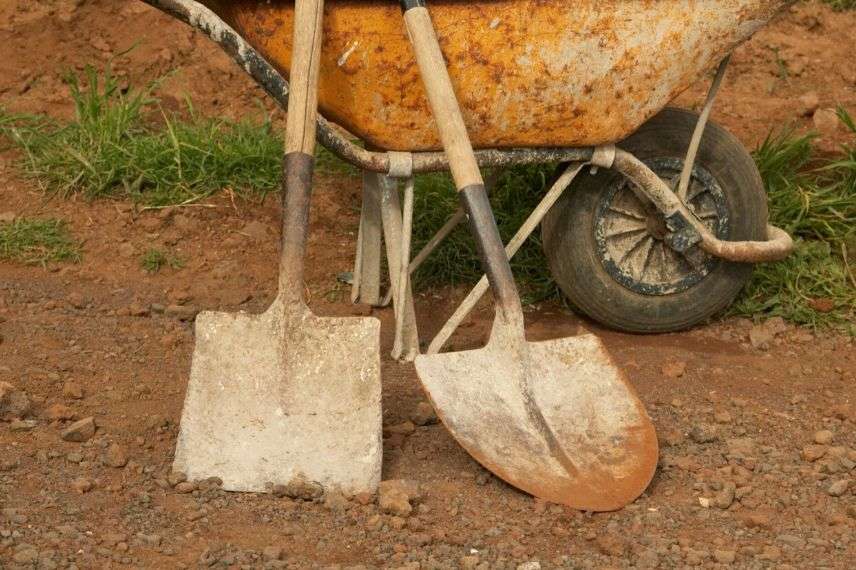
Shovels
Read also
Hoe: how to choose?Hoe and hand hoe
Hoe
A hoe consists of a long handle and a steel head shaped like a sharp blade set at an acute angle to the handle. A hoe is a tool used for hoeing, that is, breaking the surface crust of the soil. This action helps improve gas exchange and the movement of water near the roots of plants. Isn’t it said “one hoeing is worth two waterings“? Indeed, hoeing reduces watering needs. Hoeing also warms the soil around plants, accelerating the process of mineralisation of organic matter and releasing nitrogen available to plants.
In fact, hoes can also be used for weeding when you scrape the soil to remove “weeds” or adventives. But if you want the tool truly suited to that task, you should choose a weeding hoe.
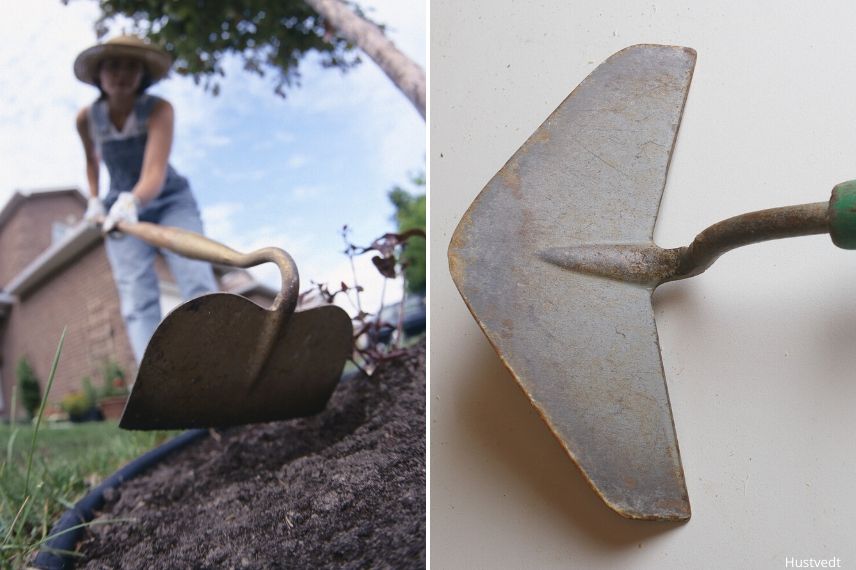
Hoe and weeding hoe
→ discover the Japanese hoe, a versatile tool that can also weed, scrape and rake soil. Olivier shows it in a video!
Rakes
“Rake” is a name that covers several different tools. There are indeed various types of rakes whose uses are very specific. Some are used for levelling soil or gravel, while others are used for cleaning, for example collecting cut herbs or dead leaves.
The classic rake
This type of rake is useful for levelling a surface of soil before sowing, for example. A classic rake has a long handle made of wood and a steel head with a width of 30 to 60 centimetres (sometimes narrower for precision work or wider for large areas) equipped with numerous straight tines that level the soil while making it slightly more friable.
The gravel rake
It looks very similar to the classic rake but has more curved tines better suited to moving gravel.
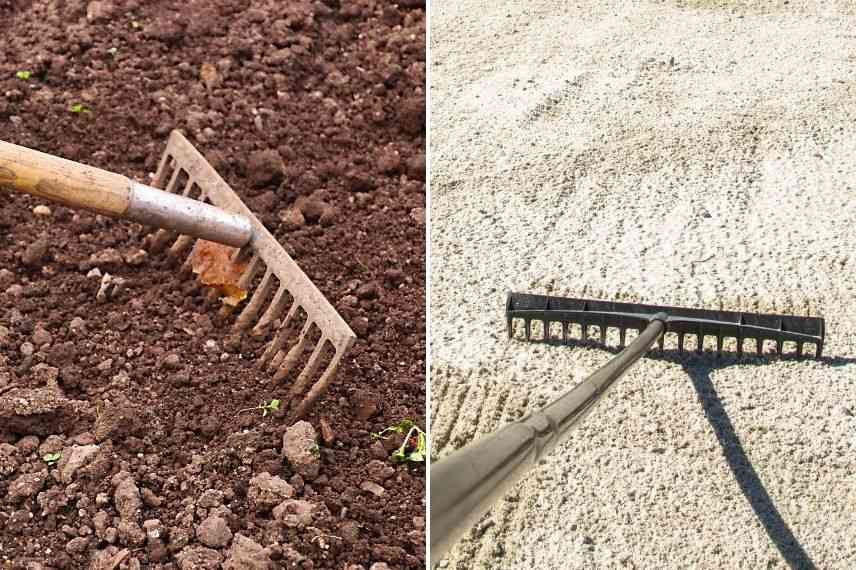
Classic and gravel rakes
The leaf rake
This is a so-called “fan” rake because it is fitted with a head made up of several flexible, long, thin lamellae. This tool gathers dead leaves and collects dry herbs that can accumulate on top of the lawn.
The scarifying rake
Very similar to the previous one, it is however fitted with blades that allow aeration of short grass meadows by removing moss, hence the name “scarifying rake“.
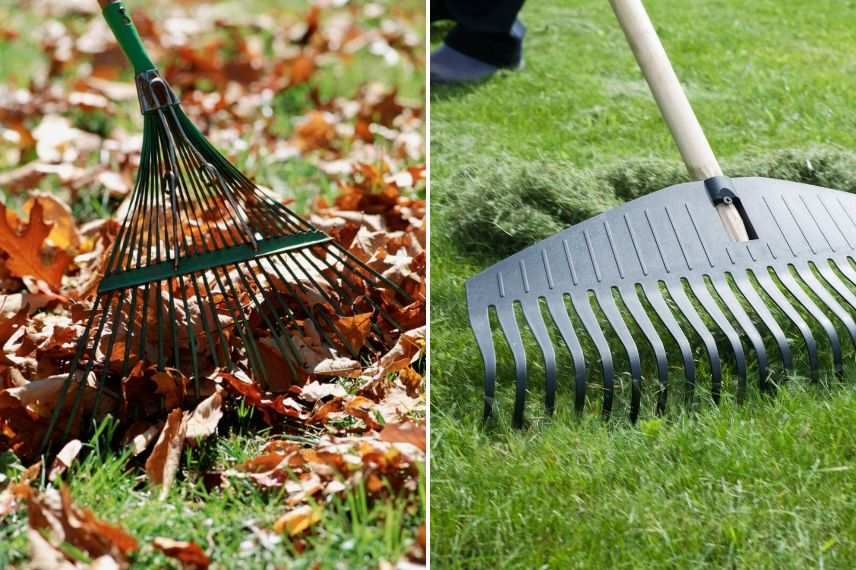
Leaf rakes and scarifying rake
The flower rake
This small hand rake is useful for cleaning flower pots or for combing roots just before repotting or when unpotting new purchases to remove any possible root tangle.
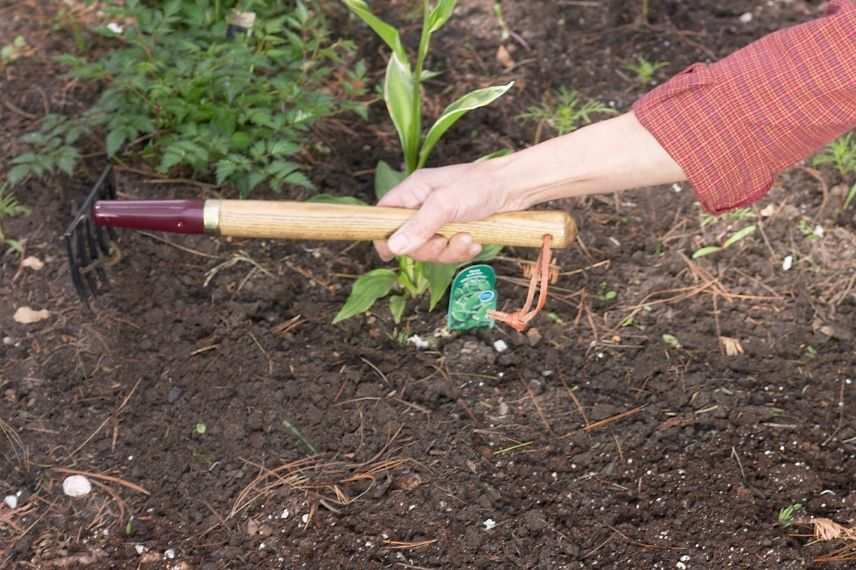
Flower rake
Claw or hook
Known as “griffe” or “croc”, it was once used as a “manure hook”. Nowadays this gardening tool has many other uses. A garden griffe aerates soil, making it lighter and more friable when used after digging. A simple “coup de griffe” is useful for breaking up the larger clods of soil and thus beginning levelling of the soil before sowing or planting. The griffe or croc consists of a long handle in wood fitted with a head shaped like a fork with three or four tines but completely curved. Best crocs have a forged steel head.
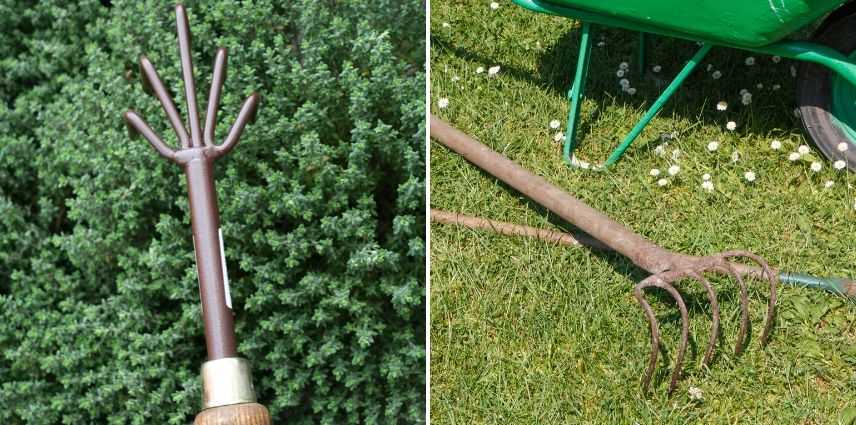
Griffe and croc
Hand hoes
Even if its name sounds ridiculous, don’t overlook a serfouette! There are versions for every taste and use. Sometimes long-handled, sometimes a small hand tool, this gardening tool always has a head fitted with two different implements: a panne, a flat blade that lets you weed, dig small holes, hoe or earth up certain plants; a langue, a small pointed blade that breaks crusted soil and digs furrows; or two or three U-shaped tines that aerate soil between plants. The most common hand-held serfouettes are the combinations “panne and griffe” while long-handled versions are mostly “panne and langue“. Choose serfouettes according to your needs.
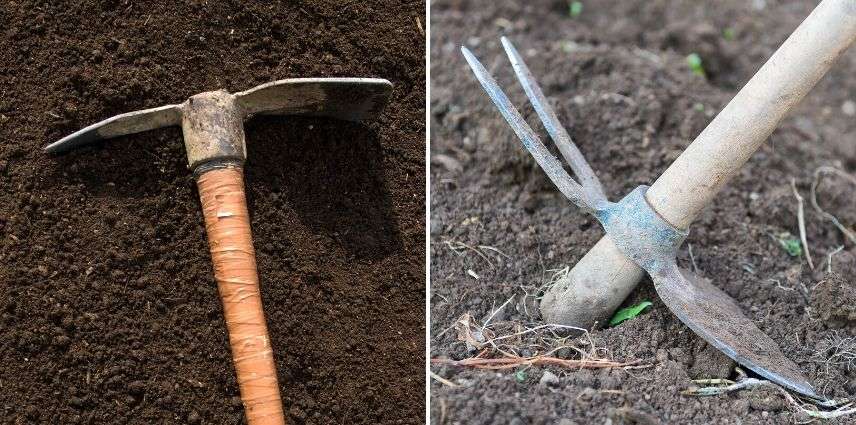
Hand hoes
Hoe
The hoe is the agricultural and gardening tool used daily around the world except… us Westerners. I exaggerate, but it is becoming increasingly difficult to find a good hoe in our garden centres. Yet it is an absolutely indispensable tool. A hoe consists of a flat blade set at roughly 90° to the shaft and mounted on a long sturdy handle. This steel head can also be fitted with teeth. Various sizes are available, to be chosen according to use, user and your soil. A heavier tool will be more effective in hard soil but will tire you more quickly. A narrow blade will be more useful for moving between plants. It’s up to you! The hoe is used to stir and crumble soil after spading (or instead of it), weed, hoe, earth up, dig furrows, trenches or planting holes…
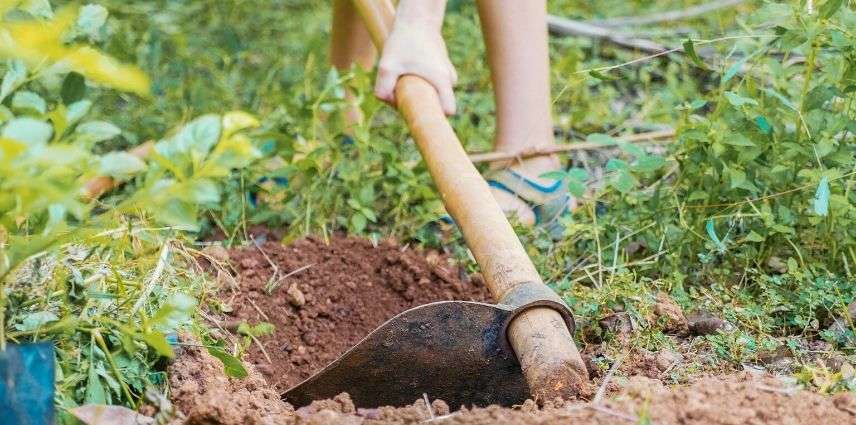
Hoe
Pickaxe
One of the oldest tools in human history remains extremely useful for earthmoving and soil preparation, in heavy or stony soils. The pickaxe consists of a steel head fixed via an eye to a hard wood handle. This steel head has, on one side, a point for breaking up solid material and, on the other side, a small rectangular-section blade — a tongue ending in a cutting edge used like a mini hoe in loosened soil.
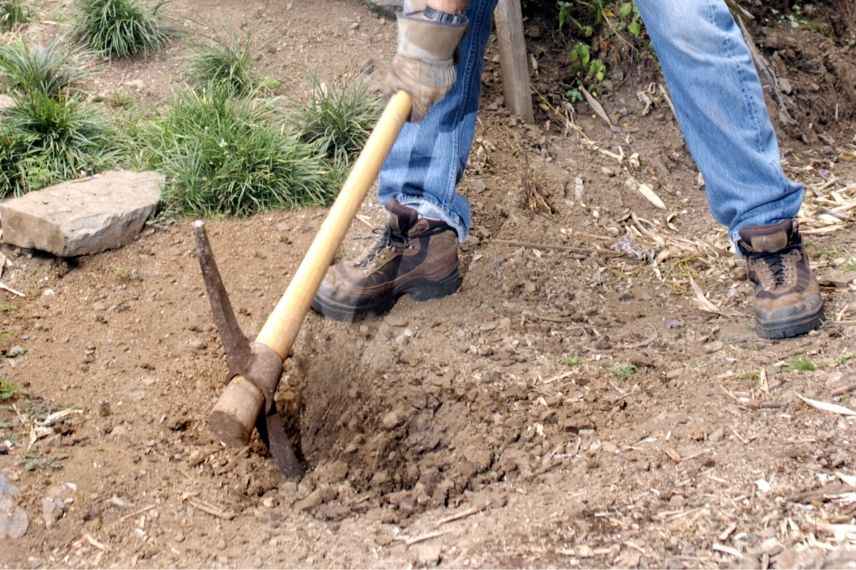
Pickaxe
Dibbers and transplanting trowels
Hand trowel
A hand trowel is a kind of very small shovel with a short handle. A hand trowel is used to break surface soil crust, to dig planting holes, to mix substrates or amendments, to open soil to place bulbs or seeds, or to transplant (hence the name) small plants by slipping beneath their roots. Do not choose your hand trowel lightly: it must be sturdy (avoid plastic), “fit” perfectly in the hand thanks to an ergonomic handle and, if possible, have a non-slip grip. Models with a “narrow blade” are better suited to pot planting and clay soils.
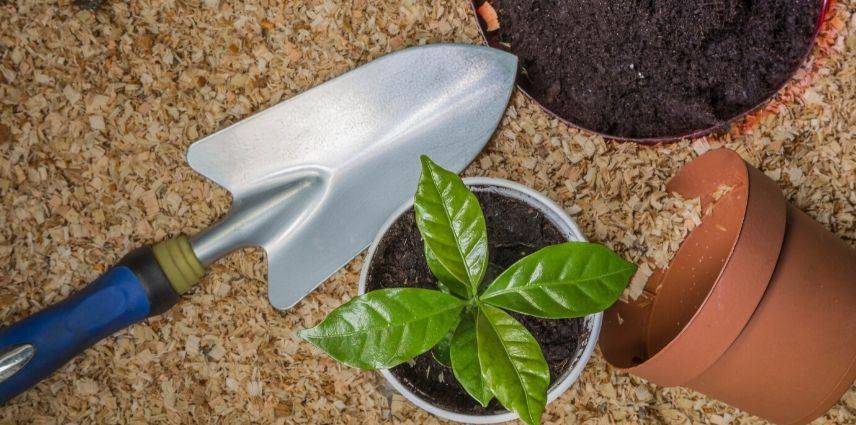
Hand trowel
More specialised dibbers
There are single dibbers, cone-shaped spikes made of hardwood, steel or composite materials. They are used to dig holes of various widths in soil to plant small plants, young vegetable plants, large seeds, bulbs…
Bulb dibbers are more elaborate. They are cylinder-like metal tubes topped by a handle. Simply push the tool into the soil to dig a hole of suitable depth (this type of tool is often graduated). Once the hole is made, drop one or several bulbs (or seed potatoes) into it, then press the handle which opens the dibber and releases the extracted soil. There are now versions of this dibber with a long handle that save you from bending down.
Mixed dibbers resemble single dibbers but are hollow, allowing seeds or bulbs to be slid directly into the hole. They are more effective in clay soils than bulb dibbers.
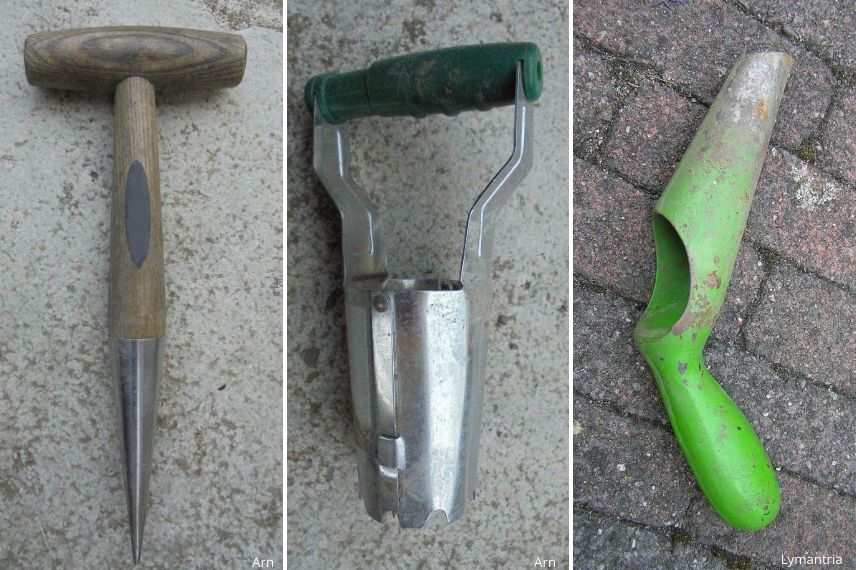
Dibber, bulb dibber and mixed dibber
Discover:
- our wide range of planting tools
- must-have Rock’n Root dibber by Olivier in our video
- our advice sheet: Dibber, hand trowel: which tool to choose for each use?
Weeding knife
This tool is a knife in name only, but it is nonetheless very useful for… weeding. The weeding knife actually consists of a long “blade” of about fifteen centimetres fixed to a sturdy handle of the same length. The action is to push this knife into the soil right at the base of the “weeds”, especially those with a taproot such as the dandelion. You then use it as a lever and… hey presto! the root pops out of the soil. One drawback: this type of tool can only be used occasionally in your short grass meadow or in your vegetable garden, otherwise you risk doing nothing else in your garden! Choose your weeding knife well: it must be sturdy and made from materials that withstand high pressure. A steel blade at least 2 mm thick will be perfect.
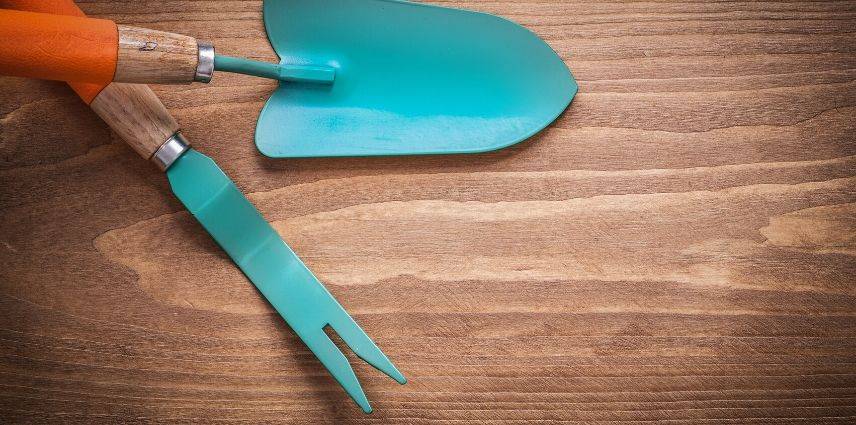
Weeding knife
Garden knife
A proper knife this time! To pick your vegetables, your flowers, mushrooms, to weed… but also to open parcels, cut ties… In short, if your pruning shear stays in your left pocket for the whole time you spend in the garden, your garden knife will be in your right pocket to deal with any eventuality. Choose one as sturdy as possible with a sharp, pointed stainless steel blade. It should also be easy to maintain (sharpening and cleaning) and able to withstand almost anything: dirt, cold, moisture… Opt for quality but don’t buy one that is too expensive either. It’s only a single garden knife and it’s more a tool than an ornamental blade…
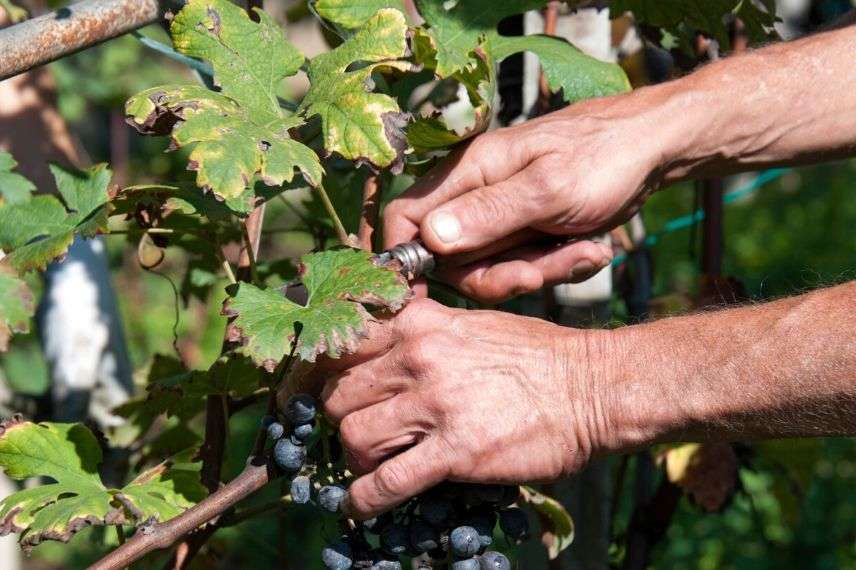
Knife
Find out more
Also read our article: Gardening for beginners: how to choose the right tools?
- Subscribe!
- Contents
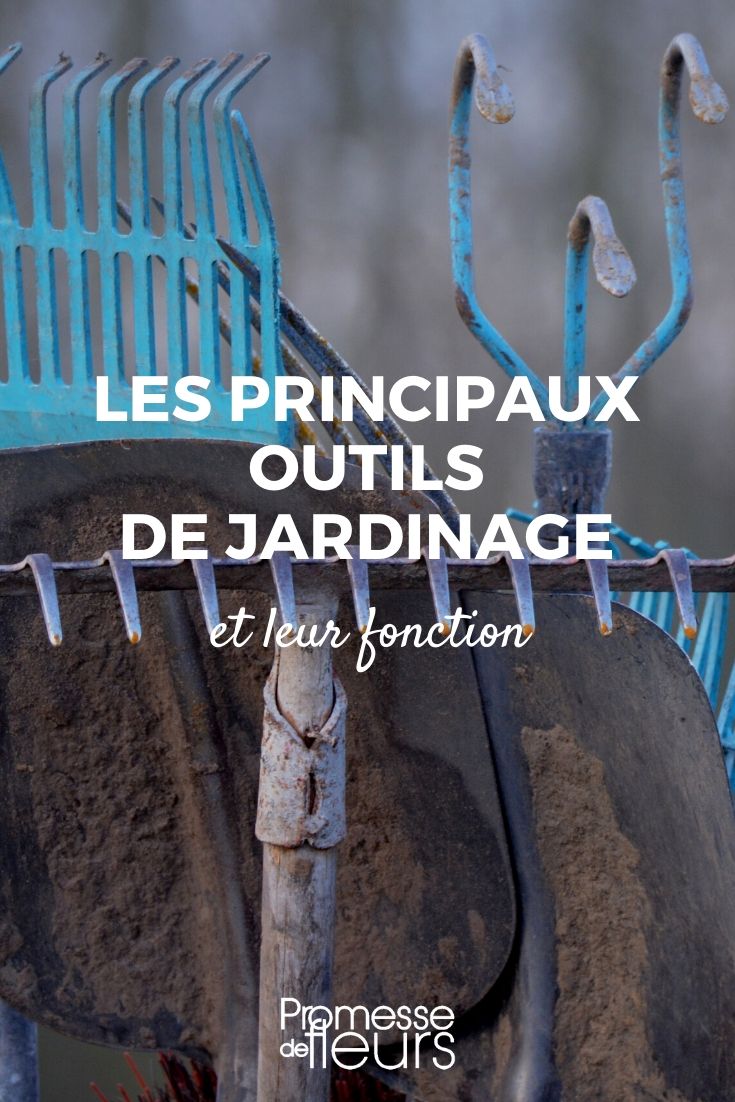































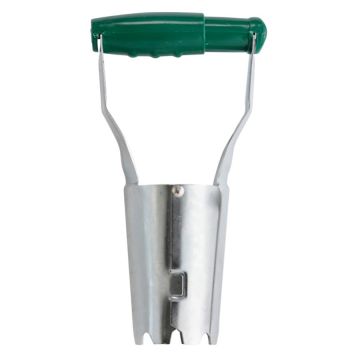
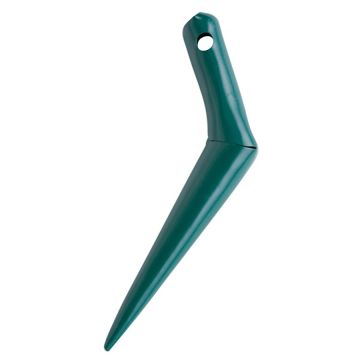
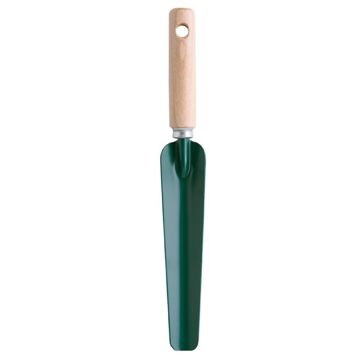
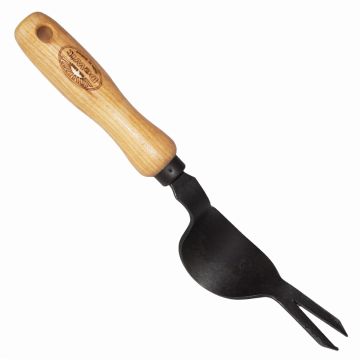
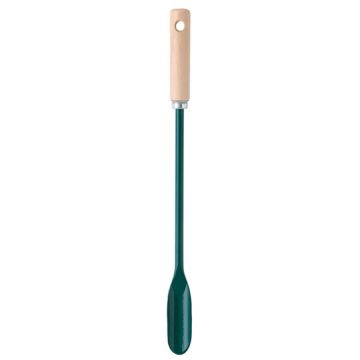
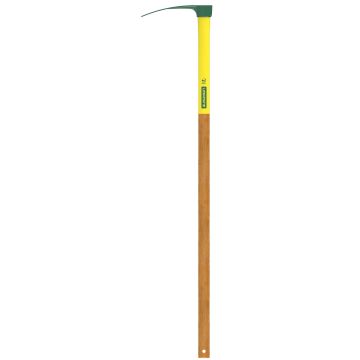
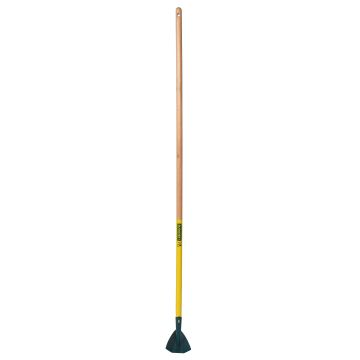

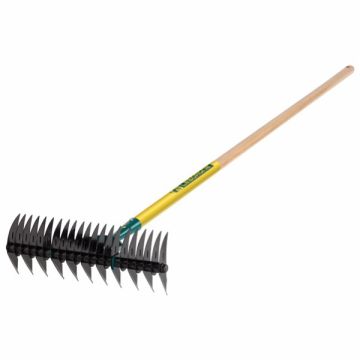
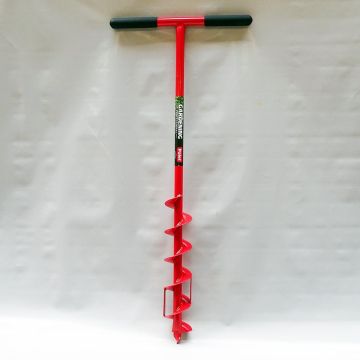
Comments